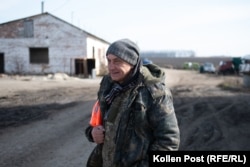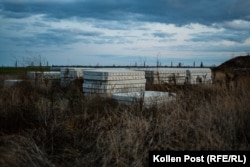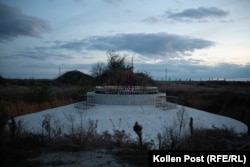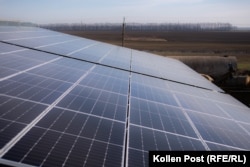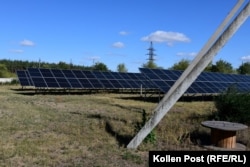ZHASHKIV, Ukraine -- Vadym Kolisnyk stands on a rooftop on the eastern edge of Zhashkiv. It’s the end of February, and the dark and fog that shroud central Ukraine for much of the winter have broken. The sun has returned to Cherkasy Oblast.
This is good news for Kolisnyk, for whom the sun is money. Solar panels stretch along aluminum frames that go all the way to the eastern face of the barn roof on which he stands. Beyond, fields of grain wait for sowing. The lowing of some 3,000 cows, mostly Holsteins, rises to the rooftop – along with the smell, inescapable now that the thaw has come.
Zhashkiv straddles the main highway between Uman and Bila Tserkva in Cherkasy Oblast, about 150 kilometers south of Kyiv. Kolisnyk lives in the city of Cherkasy, installing independent solar systems like this one from there to the Kyiv Oblast with his company, SolarGlass.
A year ago, Zhashkiv had virtually no solar power systems. But as Kolisnyk tells it, by virtue of knowing the right people, over the past year he’s become the go-to guy for solar within this town of 12,000.
Russia’s war against Ukraine has shifted his focus from big commercial plants to private homes and small businesses, but he has more orders than he can manage – in large part because six of his employees have gone to the front since the full-scale invasion of February 2022. Two remain there, while four “are no longer with us,” he says.
The team of installers working on the project in Zhashkiv, expected to take a few weeks to complete, stay in temporary farmhand quarters -- seven unmade beds in a small room on the second floor of a brick building between the orchard and the grain fields. DVDs in the thin black cases that suggest unofficial provenance are stacked half a meter high on the floor next to a dresser on which sits a TV. A cabbage, dishwashing detergent, a bottle of cheap Georgian brandy, and stray packs of cigarettes line the windowsills.
One of the residents, Volodymyr, says he’s saving up because his daughter was in competitive motocross but has outgrown her current bike. He has his eye on a new one for when the competitions -- on hold since the invasion -- resume.
Despite a lot of money changing hands, solar panel installations are a lean business with modest profit margins, says Kolisnyk. But he describes the long-term impact optimistically: “Locally, new electricity producers will pop up and all the consumers will have a secured supply of electricity from renewable sources.”
Builders like Kolisnyk are a small part of a big fight for Ukraine to keep the lights on. The more ambitious hope: to build green electricity into energy independence.
Power Lifting
Russia has attacked Ukraine’s electrical system continuously since the full-scale invasion began. After seizing several of the country’s biggest power plants in the initial push, Moscow’s forces have repeatedly targeted the Ukrainian grid with missiles and drones. This has forced Ukrainians to cut consumption, fortify production, and seek alternatives.
“I believe that there is no alternative to a green transformation of the economy, and Russian aggression has proved that a green transformation is one of the key foundations of security,” President Volodymyr Zelenskiy told a conference in London last June.
More recently, Russia has concentrated fire on the great tangle of transmission infrastructure in east-central Ukraine’s Dnipropetrovsk and Zaporizhzhya regions.
On the morning of March 22, Russia launched a wave of air strikes across the country, hitting key facilities including the Dnipro Hydroelectric Station in Zaporizhzhya and causing blackouts at several locations in what Energy Minister Herman Halushchenko called "the largest attack on the Ukrainian energy industry in recent times."
WATCH: Russia launched a massive assault on Ukraine's energy infrastructure on March 22, striking the country's largest dam and temporarily severing a power line at the Zaporizhzhya nuclear plant. Power outages and damage were reported nationwide:
Shahed drone strikes left some 53,000 people in several towns without electricity on February 12, according to Ukrenergo, the government-owned company that runs the national electric grid.
The March 22 onslaught and a cruise-missile attack a month earlier took out power lines feeding the Russian-occupied Zaporizhzhya Nuclear Power Plant, endangering the life support that keeps that plant from disaster. The damage was repaired in both cases.
Despite Ukraine’s remarkable endurance of winter blackouts, these attacks seem to be increasing as Ukraine’s armed forces ration air-defense missiles amid uncertainty about future Western weapons supplies, particularly from the United States.
But even before the full-scale invasion turned Ukraine’s power lines into front lines, Russia’s use of its hydrocarbon supplies as a geopolitical cudgel had pushed Ukraine to seek alternative sources in earnest.
A Transition Deferred
Ukraine formally renounced Russian gas imports in 2015 and sanctioned Russia’s big oil companies in 2018. Though a conspicuous indirect trade in fuels of “unknown origin” remained open until last May, between 2018 and 2021, Ukraine’s total installed solar and wind generation capacity quadrupled and tripled, respectively.
The two combined accounted for only 10 percent of Ukraine’s total generation in 2021, the last year for which official data is available, but they were the fastest-growing new generation source by miles -- or megawatts.
Ukraine still had to rely on Russia for the lion’s share of the uranium for its nuclear plants -- still the largest source of electricity in the country. Due to continued connection to the Soviet-era grid, Ukraine also had no choice but to buy electricity from Russia and Belarus in times of shortage -- and sell it in times of surplus -- right up until February 24, 2022.
Missed Connections
As with so many sectors of Ukraine’s innovation economy, the Russian invasion completely derailed the rapid growth in renewable energy.
The biggest wind and solar plants were in the east or along the southern corridor from Mariupol up to Kherson -- the sunniest part of the country, which also happens to get gusts off the Black Sea, and most of which Russia has held since early in the invasion.
Even on the Ukrainian-controlled side of the line, there are visible signs of a transition stalled.
In fields alongside Oshakiv, a town in the Mykolayiv Oblast west of Kherson, concrete slabs roughly the size and shape of ridged mattresses have stood in stacks like something from an industrial version of The Princess and the Pea, derelict for over two years.
The location, just a few hundred crop rows from the Black Sea, was one its builders fought for, gathering locals to persuade them that the wind farm would bring them more money without ruining their town. Then came the war.
“As it turned out, this land was under fire every day,” says Oleksandr Burdun, who was overseeing the construction of that wind plant.
Russian forces have retreated from most of the territory they occupied in the Mykolayiv Oblast early in the invasion but still hold the Kinburn Spit, which lies right across the water from Oshakiv. Many of the farmers are back to work, but the South Ukrainian Wind Power Plant won’t send anyone up hundreds of feet into the air to fuss with rotors and turbine blades.
“It was like, imagine you are waiting for the birth of your child and then something goes wrong,” Burdun says.
Burdun returned to his parents’ home in the city of Mykolayiv. Government trucks distributed guns to civilians, who waited for the Russian siege either to break or break through.
Burdun now finds himself in Kyiv, waiting to return. The prospective South Ukrainian Wind Power Plant sits idle and unfinished. Installed but left uncovered, the massive concrete bases of some of the never-completed towers resemble abandoned archeological digs.
Friendly Wind Technologies, the only turbine manufacturer in Ukraine, similarly found itself imperiled. Founded in 2011 in Kramatorsk, in the eastern region known as the Donbas, the company survived eight years of war there and about six months of the full-scale invasion before finally deciding to pull up stakes.
Power Stats
The damage is extensive. DTEK, the largest private energy company and biggest renewables producer in the country, has lost 70 percent of the value of its renewables subsidiary, according to Forbes Ukraine.
“Seventy-one percent of wind capacities are located in the occupied territory,” says Halyna Shmidt, head of analysis at the Ukrainian Wind Power Association. That is about 1.7 gigawatts (GW) worth of wind turbines behind Russian lines, including the largest wind farm in the country, near Zaporizhzhya.
For solar power, the picture is similarly dark. The two largest solar plants in the country are in occupied parts of Dnipropetrovsk Oblast, nearly 600 megawatts of capacity sitting derelict.
The distinction between “capacity” and “generation” is crucial. Capacity is the maximum power that a station can generate at one time and is measured in watts, the same as a consumer uses for a 100-watt light bulb, for example. By installed solar capacity, Ukraine at the end of 2021 was nearly at the level of Brazil or Britain -- significantly larger economies.
Generation, meanwhile, is power multiplied by time, or watt-hours -- the unit in which a home electric bill is measured, for example. In 2021, Ukraine consumed a total of 124.53 billion kWh, or about 3,000 per capita, about a third of the equivalent for someone living in the United States.
Critics of solar and wind power often point to the reliability of their generation based on natural phenomena, a legitimate drawback but a criticism that experts say also overestimates the consistency of other forms of generation.
Renewables are not alone: Russia has targeted Ukraine’s energy infrastructure more broadly. A UN report estimated that Ukraine’s total national generating capacity dropped from 36 GW to 13.9 GW from the beginning of the full-scale invasion to the end of 2022.
Ukrenergo wrote in May 2023 that Ukraine lost four GW of total capacity to Russian occupation in the Donbas prior to the full-scale invasion. That number rose to 21 GW after the first year, and to 27 GW by the middle of 2023.
The most prominent examples include the Zaporizhzhya Nuclear Power Plant and the Kakhovka dam. At just under 6 GW, the former is the largest power plant of any kind in Europe and remains under Russian control. The Kakhovka dam, not a particularly big hydroelectric generator, was destroyed in June 2023 with disastrous consequences.
Many power plants on the Ukrainian-controlled side of the line are closed off and heavily guarded. Military checkpoints flank the series of dams along the Dnieper.
Winds Of Change?
Despite taking a massive hit, renewable energy providers have started to adapt.
While nuclear power remains king, all of Ukraine’s nuclear power plants were built or started in the Soviet era. In January, the Energy Ministry announced plans to begin building four new reactors at the Khmelnytskiy nuclear power plant this year -- two using Russian equipment that would be imported from Bulgaria and two using technology from the U.S. company Westinghouse, which would be the first Western-based nuclear reactors in Ukrainian history.
Pushed out of the Donbas, Friendly Wind Technologies has been “welcomed hospitably” in its new home in Perechyn, in an industrial zone next to the western border city of Uzhhorod, says CEO Vladyslav Yeremenko. But the transition was tough, he said. The company only returned to production at the end of 2023 and is now making “two or three turbines per month.”
The firm is building a 500 MW wind farm in the Carpathian Mountains -- underutilized land, says Yeremenko. The project is one he estimates will take five years but, if built today, would be the largest in the country by far.
About 40 kilometers northwest of Oshakiv, where Burdun’s project lies fallow, the Tylihulska Power Plant is the biggest project of its kind to begin operations during wartime. Insulated from the Russian line, DTEK set up 19 massive 6 MW turbines that have put over 375 million kilowatts (KWh) into the southern Ukrainian grid between April 2023 and the present day, a DTEK representative told RFE/RL.
De-Russification
Russia's war has prompted some of the billionaire tycoons who made fortunes in extractive energy behemoths often linked to Russia to pursue more alternative energy plans and pushed them closer to the government in Kyiv.
Many of Ukraine’s energy titans maintained ties with Russia and the Kremlin up to the start of the full-scale invasion.
“Then Putin comes,” Yaroslav Yurchyshyn, a former head of Transparency International Ukraine and now a member of parliament, told RFE/RL. “Russia occupies their factories and their land, and they’re like, ‘We were partners. Why did you do that?’”
“The key patron in the multi-pyramid network was not the oligarchs or the leaders of the state loyal to them, but Russia itself,” Dmytro Tuzhanskiy, director of the Institute for Central European Strategy, a think tank based in Uzhhorod, wrote last year.
Rinat Akhmetov, the richest man in the country, owns DTEK, which is building the largest renewable projects in the country.
“Akhmetov decided to be a partner to the Ukrainian government. And now all his media activity works very closely with the office of the president,” Yurchyshyn said. A representative for Akhmetov did not respond to a request for comment.
According to corporate documents, Friendly Wind Technologies is ultimately owned by Eduard Mkrtchyan, the son of Armenian-Ukrainian tycoon Oleh Mkrtchyan, a Donbas industrialist who was sentenced to nine years in prison in Russian in 2019.
In a largely unheralded but crucial achievement in the early days of the full-scale invasion, Ukraine transitioned from the former Soviet IPS/UPS grid over to the European Union’s ENTSO-E grid in under two weeks starting from February 24, 2022. This has allowed Ukraine to buy up energy from Moldova, Slovakia, and Poland in times of need -- the prior alternatives being Russia and Belarus. It’s a situation the Baltic states are likewise hurrying to fix.
“Integration with ENTSO-E means for Ukraine de-weaponization of the electricity and grid dependencies from Russia,” wrote Tuzhanskiy.
Decentralization
While the specific numbers are unavailable, Ukraine has managed to make it through two winters, the most recent with a remarkable absence of lengthy blackouts.
The priority for the government is avoiding focal points for targeting. Decentralization, in other words -- something that the energy minister, Halushchenko, has repeatedly described in recent comments as a core virtue in rebuilding Ukrainian energy as he woos foreign investment.
While secretive about many electricity statistics, Ukrenergo publishes numbers on the import and export of electricity daily. Despite the Russian onslaught and occupation of about one-fifth of the country, Ukraine has resumed exporting electricity to the EU market.
Less widely publicized than the destruction of the Kakhovka dam or the capture of the Zapororizhzhya nuclear power plant, Russian forces also came within about 30 kilometers of Yuzhnoukryainsk, site of the country’s second-largest nuclear plant as well as the Tashlyk Hydroelectric Station, one of only two completed this century.
Russian forces pushing north and west were stopped near Voznesensk, south of Yuzhnoukrayinsk, and then pushed back farther south in a major Ukrainian counteroffensive in the fall of 2022. The local government set up a solar station at the site of its municipal pumping station to keep the water running in the event of more attacks.
On The Ground
Back in Zhashkiv, Kolisnyk says that today, most of the people ordering independent solar power systems are ultimately in it for the bottom line.
For one thing, the government has rejiggered its “green tariff,” a pre-invasion subsidy that motivated a lot of private solar panel installations. While existing stations are grandfathered in, the newer rates are fairly low. On the flip side, the prices for home electricity have risen dramatically to the point that they’ve become a punchline for bitter jokes nationwide.
People don’t buy these independent solar electricity systems to contribute to the grand plan of rebuilding the Ukrainian grid, he says. They buy them in part as a safeguard against blackouts, but most importantly to reduce electric bills.
“There were blackouts here, but they had a diesel generator -- a good gizmo but not totally reliable. But the main goal here isn’t to stop blackouts, it’s to minimize spending on energy resources. Because we all know, you know, prices now are pretty steep,” says Kolisnyk. “A penny saved is a penny earned.”
The farm that is getting 1 megawatt’s worth of solar panels on its roofs, for example, spends the equivalent of about 500 euros per hour on electricity, Kolisnyk estimates. If the math works out right, the panels will cover the farm’s needs over the spring, summer, and fall with enough profit to pay for the winter months.
Closer to the center of Zhashkiv, the Zayets family lives in a small house with a yard filled with two rigs of solar panels angled towards the south. Vasyl Zayets happily gestures to them, saying: “That’s my pension standing out there.”
His teenage son, Dima, shows off a phone app tallying the money coming in. At 1 p.m. on a day in late February, he counted more than 400 hryvnyas ($11) in profit from sales back to the grid.
It doesn’t sound like much but, considering that Ukrainian retirees get less than $200 a month, it’s not a bad deal. And when the weather gets rougher, the Zayets’ solar panels have the benefit of shielding a stack of firewood tucked under them from the elements.





